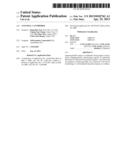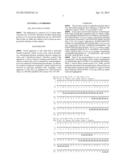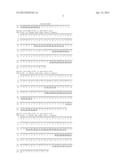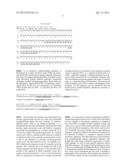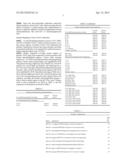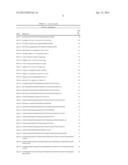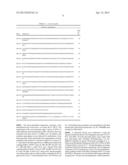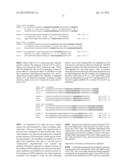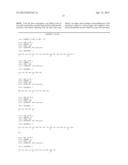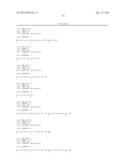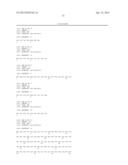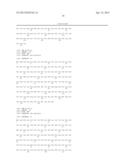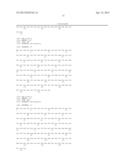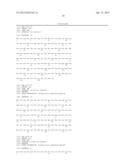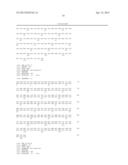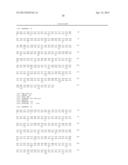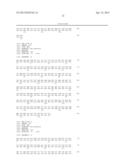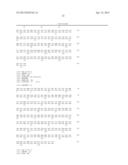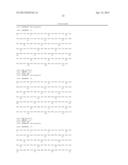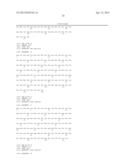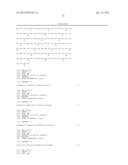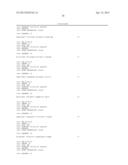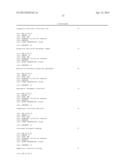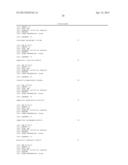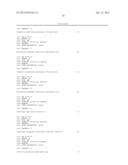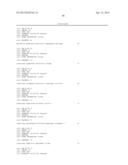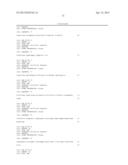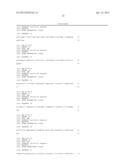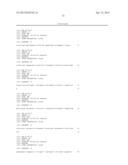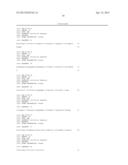Patent application title: ANTI-PSGL-1 ANTIBODIES
Inventors:
Rong-Hwa Lin (Palo Alto, CA, US)
Rong-Hwa Lin (Palo Alto, CA, US)
Chung Nan Chang (Foster City, CA, US)
Chung Nan Chang (Foster City, CA, US)
Pei-Jiun Chen (Taipei, TW)
Chiu-Chen Huang (Taipei, TW)
IPC8 Class: AC07K1628FI
USPC Class:
5303873
Class name: Globulins immunoglobulin, antibody, or fragment thereof, other than immunoglobulin antibody, or fragment thereof that is conjugated or adsorbed chimeric, mutated, or recombined hybrid (e.g., bifunctional, bispecific, rodent-human chimeric, single chain, rfv, immunoglobulin fusion protein, etc.)
Publication date: 2013-04-25
Patent application number: 20130102762
Abstract:
Immunoglobulin chains or antibodies having light or heavy chain
complementarity determining regions of antibodies that bind to P-Selectin
Glycoprotein Ligand-1. Also disclosed are methods of inducing death of an
activated T-cell and of modulating a T cell-mediated immune response in a
subject.Claims:
1-12. (canceled)
13. An antibody that binds specifically to amino acid residues 115-126 of mature human P-Selectin Glycoprotein Ligand 1.
14. The antibody of claim 13, wherein the antibody binds specifically to amino acid residues 117-123 of mature human PSGL-1.
15. The antibody of claim 13, wherein the antibody binds specifically to amino acid residues 119-121 of mature human PSGL-1.
16. The antibody of claim 13, wherein the antibody comprises a light chain and a heavy chain comprising, respectively, SEQ ID NOs: 1-3 and SEQ ID NOs: 4-6.
17. The antibody of claim 16, wherein the antibody comprises the light chain variable region of SEQ ID NO: 25 and the heavy chain variable region of SEQ ID NO: 26.
18. The antibody of claim 13, wherein the antibody, upon binding to human PSGL-1 expressed on an activated T cell, induces death of the activated T cell.
19. The antibody of claim 13, wherein the antibody is a humanized antibody.
20. The antibody of claim 13, wherein the antibody is a chimeric antibody.
21. A composition comprising the antibody of claim 13.
Description:
RELATED APPLICATIONS
[0001] This application is a division of U.S. patent application Ser. No. 11/125,837, filed May 10, 2005, which claims priority to U.S. Provisional Application Ser. No. 60/569,892, filed on May 10, 2004, the contents of all of which are incorporated by reference in their entirety.
BACKGROUND
[0002] Overly aggressive T cells often lead to unwanted immune responses, which, in turn, cause various disorders, e.g., autoimmune diseases, transplant rejection, allergic diseases, and T cell-derived cancers. Therefore, control of the aggressive T cells is critical in treating such disorders. The activity of these cells can be contained by immunosuppression or by induction of immunological tolerance. An alternative solution is induction of apoptosis, which is believed to be involved in removing unwanted cells, including overly aggressive T cells. See, e.g., Kabelitz et al. (1993) Immunol Today 14, 338-340; and Raff (1992) Nature 356, 397-399.
SUMMARY
[0003] This invention relates to antibodies and their derivatives that induce apoptosis upon binding to P-Selectin Glycoprotein Ligand-1 (PSGL-1) on activated T cells.
[0004] In one aspect, the invention features an immunoglobulin chain having three sequences that (i) contain, respectively, RSSQSIVHNDGNTYFE, KVSNRFS, and FQGSYVPLT (SEQ ID NOs: 1-3); (ii) contain, respectively, SFGMH, YINGGSSTIFYANAVKG, and YASYGGGAMDY (SEQ ID NOs: 4-6); (iii) contain, respectively, RASSTVNSTYLH, GSSNLAS, and QQYSGYPLT (SEQ ID NOs: 7-9); (iv) contain, respectively, AYYIH, VNPNTGGTSYNPKFKG, and SGSPYYRYDD (SEQ ID NOs: 10-12); (v) contain, respectively, RSSQSIVNSNGNTYLE, KVSNRFS, and FQGSHVPWT (SEQ ID NOs: 13-15); or (vi) contain, respectively, TNAMNWVRQAPGKGLE, TYYADSVKD, and GGSYWYFDV (SEQ ID NOs: 16-18).
[0005] Each of the just-described six sets of sequences corresponds to the three light or heavy chain complementarity determining regions (CDRs) of an antibody that binds to PSGL-1, such as those of three mouse 15A7, 43B6, and 9F9 antibodies described in the examples below. Shown below are the light chains and heavy chain variable (V) regions of these three antibodies (SEQ ID NOs: 19-26, the CDRs are underlined and highlighted):
TABLE-US-00001 Nucleic acid SEQ ID NO: 19 and amino acid SEQ ID NO: 27 (Mouse 15A7 light chain V region): 1 ATGAAGTTGCCTGTTAGGCTGTTGGTGCTGATGTTCTGGATTCCTGCTTCCAGCAGTGAT 1 M K L P V R L L V L M F W I P A S S S D 61 ATTTTGATGACCCAAACTCCACTGTCCCTGCCTGTCAGTCTTGGAGATCAAGCCTCAATA 21 I L M T Q T P L S L P V S L G D Q A S I ##STR00001## ##STR00002## 241 GGGGTCCCAGACAGGTTCAGTGGCAGTGGATCAGGGACACATTTCACACTCAACATCAGC 81 G V P D R F S G S G S G T H F T L N I S ##STR00003## ##STR00004## Nucleic acid SEQ ID NO: 20 and amino acid SEQ ID NO: 28 (Mouse 15A7 heavy chain V region): 1 ATGGACTCCAGGCTCAATTTAGTTTTCCTTGTCCTTATTTTAAAAGGTGTCCAGTGTGAT 1 M D S R L N L V F L V L I L K G V Q C D 61 GTGCAGCTGGTGGAGTCTGGGGGAGGCTTAGTGCAGCCTGGAGGGTCCCGGAAACTCTCC 21 V Q L V E S G G G L V Q P G G S R K L S ##STR00005## ##STR00006## ##STR00007## ##STR00008## ##STR00009## Nucleic acid SEQ ID NO: 21 and amino acid SEQ ID NO: 29 (Mouse 43B6 light chain V region): 1 ATGGATTTTCTGGTGCAGATTTTCAGCTTCTTGCTAATCAGTGCCTCAGTTGCAATGTCC 1 M D F L V Q I F S F L L I S A S V A M S 61 AGAGGAGAAAATGTGCTCACCCAGTCTCCAGCAATCATGTCTGCATCTCCAGGGGAAAAG 21 R G E N V L T Q S P A I M S A S P G E K ##STR00010## ##STR00011## 241 GTCCCTGCTCGCTTCAGTGGCAGTGGGTCTGGGACCTCTTACTCTCTCACAATCAGCAGT 81 V P A R F S G S G S G T S Y S L T I S S ##STR00012## 361 TTCGGTGCTGGGACCACGCTGGAGCTGAAA 121 F G A G T T L E L K Nucleic acid SEQ ID NO: 22 and amino acid SEQ ID NO: 30 (Mouse 43B6 heavy chain V region): 1 ATGGAATGGAGCTGGGTCTTTCTCTTCCTCCTGTCAGTCACTACAGGTGTCCACTCTGAG 1 M E W S W V F L F L L S V T T G V H S E 61 GTCCAGCTGCAGCAGTCTGGACCTGACCTGGTGAAGCCTGGGGCTTTAGTGAAGATATCC 21 V Q L Q Q S G P D L V K P G A L V K I S ##STR00013## ##STR00014## ##STR00015## ##STR00016## ##STR00017## Nucleic acid SEQ ID NO: 23 and amino acid SEQ ID NO: 31 (Mouse 9F9 light chain V region): 1 ATGAAGTTGCCTGTTAGGCTGTTGGTGCTGATGTTCTGGATTCCTGCTTCCAGCAGTGAT 1 M K L P V R L L V L M F W I P A S S S D 61 GTTTTGATGACCCAAACTCCACTCTCCCTGCCTGTCAGTCTTGGAGATCAAGCCTCCATC 21 V L M T Q T P L S L P V S L G D Q A S I ##STR00018## ##STR00019## 241 GGGGTCCCAGACAGGTTCAGTGGCAGTGGATCAGGGACAGATTTCACACTCAAGATCAGC 81 G V P D R F S G S G S G T D F T L K I S ##STR00020## ##STR00021## Nucleic acid SEQ ID NO: 24 and amino acid SEQ ID NO: 32 (Mouse 9F9 heavy chain V region): 1 ATGCTGTTGGGGCTGAAGTGGGTTTTCTTTGTTGTTTTTTATCAAGGTGTGCATTGTGAG 1 M L L G L K W V F F V V F Y Q G V H C E 61 GTGCAGCTTGTTGAGACTGGTGGAGGATTGGTGCAGCCTAAAGGGTCATTGAAACTCTCA 21 V Q L V E T G G G L V Q P K G S L K L S ##STR00022## ##STR00023## ##STR00024## ##STR00025## ##STR00026##
[0006] As an antibody's antigen-binding specificity is determined by its light and heavy chain CDRs, the above-described CDRs can be used to generate antibody derivatives that retain the antigen-binding specificity. Examples of antibody derivatives include chimeric antibodies, humanized antibodies, and their functional equivalents. Shown below are the light chain V region (SEQ ID NO: 25) and heavy chain V region (SEQ ID NO: 26) of a humanized 15A7 antibody, which include SEQ ID NOs: 1-3 and SEQ ID NOs: 4-6, respectively:
TABLE-US-00002 SEQ ID NO: 25 (humanized 15A7 light chain V region): ##STR00027## ##STR00028## SEQ ID NO: 26 (humanized 15A7 heavy chain V region): ##STR00029## ##STR00030##
[0007] This invention also features an isolated nucleic acid having a sequence that encodes one of the above-described immunoglobulin chains. The term "antibody" or "immunoglobulin chain" refers to an isolated polypeptide, i.e., a polypeptide that has been substantially separated from other proteins, lipids, and nucleic acids with which it is naturally associated. The polypeptide can constitute at least 50, 70, or 95% by dry weight of the purified preparation. An "isolated nucleic acid" refers to a nucleic acid the structure of which is not identical to that of any naturally occurring nucleic acid or to that of any fragment of a naturally occurring genomic nucleic acid. The term therefore covers, for example, (a) a DNA which has the sequence of part of a naturally occurring genomic DNA molecule but is not flanked by both of the coding sequences that flank that part of the molecule in the genome of the organism in which it naturally occurs; (b) a nucleic acid incorporated into a vector or into the genomic DNA of a prokaryote or eukaryote in a manner such that the resulting molecule is not identical to any naturally occurring vector or genomic DNA; (c) a separate molecule such as a cDNA, a genomic fragment, a fragment produced by polymerase chain reaction (PCR), or a restriction fragment; and (d) a recombinant nucleotide sequence that is part of a hybrid gene, i.e., a gene encoding a fusion protein. The nucleic acid of this invention can be used to express a polypeptide of this invention. For this purpose, one can operatively link the nucleic acid to suitable regulatory sequences to generate an expression vector.
[0008] A vector refers to a nucleic acid molecule capable of transporting another nucleic acid to which it has been linked, and also capable of autonomous replication or integration into a host DNA. Examples include a plasmid, cosmid, and viral vector. A vector of this invention includes a nucleic acid in a form suitable for expression of the nucleic acid in a host cell. Preferably, the vector includes one or more regulatory sequences operatively linked to the nucleic acid sequence to be expressed. Examples of a regulatory sequence include promoters, enhancers, and other expression control elements (e.g., polyadenylation signals). Regulatory sequences also include those that direct constitutive expression of a nucleotide sequence, as well as tissue-specific regulatory and/or inducible sequences. The design of such an expression vector is based on considerations including the choice of the host cell to be transformed and the desired expression level. An expression vector can be introduced into host cells to produce a polypeptide of this invention. This invention also includes a host cell that contains the above-described nucleic acid. A host cell refers to a cell containing an exogenous coding sequence or non-coding sequence. An exogenous sequence can be introduced into a cell by calcium phosphate transfection, DEAE-Dextran mediated transfection, or electroporation. Suitable host cells include bacterial cells (e.g., E. coli, Bacillus subtilis, and Salmonella typhimurium), yeast cells (e.g., Saccharomyces cerevisiae and Schizosaccharomyces pombe), plant cells (e.g., Nicotiana tabacum and Gossypium hirsutum), and mammalian cells (e.g., murine hybridoma cells, CHO cells, and 3T3 fibroblasts).
[0009] To produce an immunoglobulin chain of this invention, one can place a host cell in a culture under conditions permitting expression of a polypeptide encoded by a nucleic acid described above, and isolate the polypeptide from the culture. Alternatively, a nucleic acid of this invention can be transcribed and translated in vitro, for example, using T7 promoter regulatory sequences and T7 polymerase.
[0010] Within the scope of this invention is an antibody. It is formed by a first immunoglobulin chain and a second immunoglobulin chain, which contain, respectively, the light chain CDRs and heavy chain CDRs of the mouse 15A7, 43B6, or 9F9 antibody mentioned above. Preferably, this antibody is formed by the light and heavy chains of 15A7.
[0011] Also within the scope of this invention is another antibody that (i) binds specifically to P-Selectin Glycoprotein Ligand 1 without interfering with binding between P-Selectin Glycoprotein Ligand 1 and P-Selectin and, (ii), upon binding to P-Selectin Glycoprotein Ligand 1 on an activated T cell, induces the death of the T cell. In one embodiment, this antibody binds specifically to human P-Selectin Glycoprotein Ligand 1.
[0012] Further within the scope of this invention is still another antibody that binds specifically to amino acid residues 115-126 of mature human P-Selectin Glycoprotein Ligand 1. Preferably, the antibody binds specifically to amino acid residues 117-123. More preferably, it binds specifically to amino acid residues 119-121, a consensus sequence among all tested epitopes. Indeed, mutation of one or more of these three amino acid residues abolishes antibody binding. In one example, this antibody, upon binding to P-Selectin Glycoprotein Ligand 1 on an activated T cell, induces the death of the activated T cell.
[0013] In one embodiment, one of the two antibodies mentioned immediately above is formed by a light chain and a heavy chain that contain, respectively, SEQ ID NOs: 1-3 and SEQ ID NOs: 4-6 (e.g., SEQ ID NOs: 19 and 20, or SEQ ID NOs: 25 and 26).
[0014] In a further aspect, the invention features a method of inducing death of an activated T cell. The method includes contacting one of the three antibodies described above with an activated T cell, in which binding of the antibody to the activated T cell induces cell death.
[0015] The invention also features a method of modulating a T cell-mediated immune response in a subject. The method includes (1) identifying a subject having or as being at risk of having a condition related to an excessive T cell-mediated immune response and (2) administering to the subject an effective amount of one of the three antibodies described above. An "excessive T cell-mediated immune response" refers to a response caused by an excessive level of activated T cells. An excessive level refers to (1) a level higher than a normal level, and (2) a level higher than desired in an individual, even though it is not greater than a normal level. Examples of the condition include an inflammatory disease, an autoimmune disease, an allergic disease, or a T cell cancer, as well as the situation in which a subject has received or is contemplated to receive an allogeneic or xenogeneic transplant.
[0016] The details of one or more embodiments of the invention are set forth in the accompanying description below. Other features, objects, and advantages of the invention will be apparent from the detailed description.
DETAILED DESCRIPTION
[0017] This invention is based, at least in part, on an unexpected discovery that activated T cells can be induced to undergo apoptosis and be depleted by binding of antibodies or their derivatives to PSGL-1 on the activated cells. The antibodies and derivatives are useful for treating conditions associated with an excessive or unwanted T cell-mediated immune response or T cell proliferation.
[0018] Accordingly, the invention features polypeptides that contain immunoglobulin light or heavy chain CDRs of anti-PSGL-1 antibodies, as well as nucleic acids encoding them. Both the immunoglobulin chains and nucleic acids can be used to make the above-mentioned antibodies and derivatives.
[0019] An immunoglobulin chain of the invention can be obtained as a synthetic polypeptide or a recombinant polypeptide. To prepare a recombinant polypeptide, a nucleic acid encoding it can be linked to another nucleic acid encoding a fusion partner, e.g., Glutathione-S-Transferase (GST), 6x-His epitope tag, M13 Gene 3 protein, or an immunoglobulin heavy chain constant region. The resultant fusion nucleic acid can be introduced to a cell for protein expression. The fusion protein can be isolated from the host cell by methods well known in the art. The isolated fusion protein can be further treated, e.g., by enzymatic digestion, to remove the fusion partner and obtain the recombinant polypeptide of interest. Alternatively, an immunoglobulin chain can be obtained from a suitable host cell by activating endogenous expression of a nucleic acid encoding the chain.
[0020] The amino acid composition of an immunoglobulin chain of the invention may vary without disrupting the ability of forming an antibody capable of binding to PSGL-1. For example, such a variant can contain one or more conservative amino acid substitutions. A "conservative amino acid substitution" is one in which the amino acid residue is replaced with an amino acid residue having a similar side chain. Families of amino acid residues having similar side chains have been defined in the art. These families include amino acids with basic side chains (e.g., lysine, arginine, histidine), acidic side chains (e.g., aspartic acid, glutamic acid), uncharged polar side chains (e.g., glycine, asparagine, glutamine, serine, threonine, tyrosine, cysteine), nonpolar side chains (e.g., alanine, valine, leucine, isoleucine, proline, phenylalanine, methionine, tryptophan), beta-branched side chains (e.g., threonine, valine, isoleucine) and aromatic side chains (e.g., tyrosine, phenylalanine, tryptophan, histidine). Thus, a predicted nonessential amino acid residue in a polypeptide is preferably replaced with another amino acid residue from the same side chain family. Alternatively, mutations can be introduced randomly along all or part of a polypeptide of this invention, such as by saturation mutagenesis, and the resultant mutants can be screened for the ability of forming an antibody capable of binding to PSGL-1 to identify variants of this invention as described below in the examples. Thus, as an example, the term "an immunoglobulin chain containing SEQ ID NO: 19" covers immunoglobulin chains containing variants of SEQ ID NO: 19.
[0021] The above-described immunoglobulin chains and variants can be used to make an antibody of this invention or its derivatives. An "antibody" includes intact molecules as well as fragments thereof, such as Fab, F(ab')2, Fv, scFv (single chain antibody), and dAb (domain antibody; Ward, et. al. (1989) Nature, 341, 544). A derivative of an antibody refers to a protein or a protein complex having a polypeptide variant of this invention. An antibody or derivative of this invention can be made by co-expressing corresponding light and heavy chain CDRs-containing polypeptides in a suitable host cell as described in the examples below. Alternatively, they can be made by methods known in the art of making monoclonal and polyclonal antibodies and fragments. See, e.g., Harlow and Lane (1988) Antibodies: A Laboratory Manual, Cold Spring Harbor Laboratory, New York.
[0022] To make an antibody of this invention, PSGL-1 or its antigenic fragment can be coupled to a carrier protein, such as KLH, mixed with an adjuvant, and injected into a host animal. Antibodies produced in that animal can then be purified by peptide affinity chromatography. Commonly employed host animals include rabbits, mice, guinea pigs, and rats. Various adjuvants that can be used to increase the immunological response depend on the host species and include Freund's adjuvant (complete and incomplete), mineral gels such as aluminum hydroxide, surface active substances such as lysolecithin, pluronic polyols, polyanions, peptides, oil emulsions, keyhole limpet hemocyanin, and dinitrophenol. Useful human adjuvants include BCG (bacille Calmette-Guerin) and Corynebacterium parvum.
[0023] Polyclonal antibodies, heterogeneous populations of antibody molecules, are present in the sera of the immunized subjects. Monoclonal antibodies, homogeneous populations of antibodies to a particular antigen, can be prepared using standard hybridoma technology. See, e.g., Kohler et al. (1975) Nature 256, 495; Kohler et al. (1976) Eur. J. Immunol. 6, 511; Kohler et al. (1976) Eur. J. Immunol. 6, 292; and Hammerling et al. (1981) Monoclonal Antibodies and T Cell Hybridomas, Elsevier, N.Y. In particular, monoclonal antibodies can be obtained by any technique that provides for the production of antibody molecules by continuous cell lines in culture such as described in U.S. Pat. No. 4,376,110; the human B-cell hybridoma technique (Kosbor et al. (1983) Immunol Today 4, 72; Cole et al. (1983) Proc. Natl. Acad. Sci. USA 80, 2026) and the EBV-hybridoma technique (Cole et al. (1983) Monoclonal Antibodies and Cancer Therapy, Alan R. Liss, Inc., pp. 77-96). Such antibodies can be of any immunoglobulin class including IgG, IgM, IgE, IgA, IgD, and any subclass thereof. The hybridoma producing the monoclonal antibodies of the invention may be cultivated in vitro or in vivo. The ability to produce high titers of monoclonal antibodies in vivo makes it a particularly useful method of production.
[0024] In addition, techniques developed for the production of "chimeric antibodies" can be used. See, e.g., Morrison et al. (1984) Proc. Natl. Acad. Sci. USA 81, 6851; Neuberger et al. (1984) Nature 312, 604; and Takeda et al. (1984) Nature 314, 452. A chimeric antibody is a molecule in which different portions are derived from different animal species, such as those having a variable region derived from a murine monoclonal antibody and a human immunoglobulin constant region. Alternatively, techniques described for the production of single chain antibodies (U.S. Pat. Nos. 4,946,778 and 4,704,692) can be adapted to produce a phage library of single chain Fv antibodies. Single chain antibodies are formed by linking the heavy and light chain fragments of the Fv region via an amino acid bridge. Moreover, antibody fragments can be generated by known techniques. For example, such fragments include, but are not limited to, F(ab')2 fragments that can be produced by pepsin digestion of an antibody molecule, and Fab fragments that can be generated by reducing the disulfide bridges of F(ab')2 fragments. Antibodies can also be humanized by methods described in the examples below or known in the art. For example, monoclonal antibodies with a desired binding specificity can be commercially humanized (Scotgene, Scotland; and Oxford Molecular, Palo Alto, Calif.). Fully humanized antibodies, such as those expressed in transgenic animals are within the scope of the invention (see, e.g., Green et al. (1994) Nature Genetics 7, 13; and U.S. Pat. Nos. 5,545,806 and 5,569,825).
[0025] Also within the scope of this invention is a method of inducing death of activated T cells, e.g., by contacting activated T cells with an antibody of the invention in vitro, and by administering to a subject in need thereof an effective amount of the antibody. Subjects to be treated can be identified as having or being at risk for having a condition related to an excessive or unwanted T cell-mediated immune response, e.g., patients suffering from autoimmune diseases, transplant rejection, allergic diseases, or T cell-derived cancers. This method can be performed alone or in conjunction with other drugs or therapy.
[0026] The term "treating" refers to administration of a composition to a subject with the purpose to cure, alleviate, relieve, remedy, prevent, or ameliorate a disorder, the symptom of the disorder, the disease state secondary to the disorder, or the predisposition toward the disorder. An "effective amount" is an amount of the composition that is capable of producing a medically desirable result in a treated subject.
[0027] Exemplary diseases to be treated include diabetes mellitus, arthritis (including rheumatoid arthritis, juvenile rheumatoid arthritis, osteoarthritis, and psoriatic arthritis), multiple sclerosis, encephalomyelitis, myasthenia gravis, systemic lupus erythematosus, autoimmune thyroiditis, dermatitis (including atopic dermatitis and eczematous dermatitis), psoriasis, Sjogren's Syndrome, Crohn's disease, aphthous ulcer, iritis, conjunctivitis, keratoconjunctivitis, type I diabetes, inflammatory bowel diseases, ulcerative colitis, asthma, allergic asthma, cutaneous lupus erythematosus, scleroderma, vaginitis, proctitis, drug eruptions, leprosy reversal reactions, erythema nodosum leprosum, autoimmune uveitis, allergic encephalomyelitis, acute necrotizing hemorrhagic encephalopathy, idiopathic bilateral progressive sensorineural hearing loss, aplastic anemia, pure red cell anemia, idiopathic thrombocytopenia, polychondritis, Wegener's granulomatosis, chronic active hepatitis, Stevens-Johnson syndrome, idiopathic sprue, lichen planus, Graves' disease, sarcoidosis, primary biliary cirrhosis, uveitis posterior, interstitial lung fibrosis, graft-versus-host disease, cases of transplantation (including transplantation using allogeneic or xenogeneic tissues) such as bone marrow transplantation, liver transplantation, or the transplantation of any organ or tissue, allergies such as atopic allergy, AIDS, and T cell neoplasms such as leukemias or lymphomas.
[0028] In one in vivo approach, a therapeutic composition (e.g., a composition containing an antibody of the invention) is administered to the subject. Generally, the antibody is suspended in a pharmaceutically-acceptable carrier (e.g., physiological saline) and administered orally or by intravenous infusion, or injected or implanted subcutaneously, intramuscularly, intrathecally, intraperitoneally, intrarectally, intravaginally, intranasally, intragastrically, intratracheally, or intrapulmonarily.
[0029] The dosage required depends on the choice of the route of administration; the nature of the formulation; the nature of the subject's illness; the subject's size, weight, surface area, age, and sex; other drugs being administered; and the judgment of the attending physician. Suitable dosages are in the range of 0.01-100.0 mg/kg. Variations in the needed dosage are to be expected in view of the variety of compositions available and the different efficiencies of various routes of administration. For example, oral administration would be expected to require higher dosages than administration by intravenous injection. Variations in these dosage levels can be adjusted using standard empirical routines for optimization as is well understood in the art. Encapsulation of the composition in a suitable delivery vehicle (e.g., polymeric microparticles or implantable devices) may increase the efficiency of delivery, particularly for oral delivery.
[0030] Also within the scope of this invention is a pharmaceutical composition that contains a pharmaceutically-acceptable carrier and an effective amount of an antibody of the invention. The pharmaceutical composition can be used to treat diseases described above. The pharmaceutically-acceptable carrier includes a solvent, a dispersion medium, a coating, an antibacterial and antifungal agent, and an isotonic and absorption delaying agent.
[0031] The pharmaceutical composition of the invention can be formulated into dosage forms for different administration routes utilizing conventional methods. For example, it can be formulated in a capsule, a gel seal, or a tablet for oral administration. Capsules can contain any standard pharmaceutically-acceptable materials such as gelatin or cellulose. Tablets can be formulated in accordance with conventional procedures by compressing mixtures of the composition with a solid carrier and a lubricant. Examples of solid carriers include starch and sugar bentonite. The composition can also be administered in a form of a hard shell tablet or a capsule containing a binder, e.g., lactose or mannitol, a conventional filler, and a tableting agent. The pharmaceutical composition can be administered via the parenteral route. Examples of parenteral dosage forms include aqueous solutions, isotonic saline or 5% glucose of the active agent, or other well-known pharmaceutically-acceptable excipient. Cyclodextrins, or other solubilizing agents well known to those familiar with the art, can be utilized as pharmaceutical excipients for delivery of the therapeutic agent.
[0032] The efficacy of a composition of this invention can be evaluated both in vitro and in vivo. See, e.g., the examples below. Briefly, the composition can be tested for its ability to induce death of activated T cells in vitro. For in vivo studies, the composition can be injected into an animal (e.g., a mouse model) and its therapeutic effects are then accessed. Based on the results, an appropriate dosage range and administration route can be determined.
[0033] The specific examples below are to be construed as merely illustrative, and not limitative of the remainder of the disclosure in any way whatsoever. Without further elaboration, it is believed that one skilled in the art can, based on the description herein, utilize the present invention to its fullest extent. All publications recited herein are hereby incorporated by reference in their entirety.
EXAMPLE 1
Mouse Monoclonal Antibodies 15A7, 43B6, and 9F9 Generation of Anti-PSGL-1 Antibodies
[0034] Standard techniques were used to generate mouse monoclonal antibodies that specifically bound to human PSGL-1 (hCD162). More specifically, mice were immunized with membrane fraction of PHA-activated human T cells and sacrificed to generate hybridoma cell lines. Supernatants from resultant hybridoma cell lines were screened for binding to CHO cells that stably expressed hCD162. Those lines producing antibodies that bound to hCD162-expressing CHO cells, but not the parental CHO cells, were identified, subcloned, and further analyzed as described below.
[0035] Among the lines identified were m152-15A7, m166-43B6, and m128-9F9. They produced IgG1 antibodies 15A7, 43B6, and 9F9, respectively. Immunoblotting assay showed that these three antibodies pulled down from lysate of activated T-cells a protein that could be detected by anti-hCD162 antibody (kp1-1, PharMingen, San Diego, Calif.).
[0036] The just-described three antibodies were tested for their abilities to induce apoptosis of activated T cells. Culture supernatants containing monoclonal antibodies secreted by the three hybridoma cell lines were respectively incubated with either non-activated human T cells (Day 0) or in vitro activated human T cells (Day 7) for 6 hours. The cells were then stained with annexin V and subjected to FACS analysis. CD3-positive cells were gated to ensure counting of either in vitro activated human T cells or resting human T cells. The apoptotic cells were annexin V staining-positive. Table 1 summarizes the percentage of apoptotic T cells among all of the T cells scanned.
TABLE-US-00003 TABLE 1 Percentage of apoptotic T cells Un- Anti- m128- Un- Anti- m152- M166- treated myc 9F9 treated myc 15A7 43136 Day 0 4.17 6.67 5.82 18.18 15.52 5.23 6.57 Day 7 12.63 13.36 28.71 24.18 23.08 51.66 49.44
[0037] These results indicate that mouse 15A7, 43B6, and 9F9 antibodies (1) are hCD162-specific and (2) can bind to human activated T cells and induce apoptosis of activated T cells, but not resting human T cells.
[0038] Apoptosis assay was also conducted on PHA-activated human peripheral blood mononuclear cells (PBMC). It was found that the antibodies only induced apoptosis in activated T cells, but not in resting T cells, B cells, or in neutrophils.
[0039] It is known that T cell-depleting antibodies, such as anti-CD3, are able to induce production of soluble factors. Therapy using such antibodies usually results in a deleterious cytokine syndrome. To test if anti-PSGL-1 antibody also caused cytokine-associated side effects, freshly isolated human PBMC were cultured with 15A7 for 24, 48, or 72 hours. The levels of cytokines in the supernatant were then determined. Considerable amounts of IL-2, TNF-α, and IFN-γ were produced in PHA-activated PBMC (positive control), while levels of these cytokines from 15A7-treated cells were not detectable. These results supported that anti-PSGL-1 has no or little effect on resting peripheral blood cells, in both aspects of apoptotic induction and cell activation.
[0040] Since the above-described antibodies selectively induce apoptosis of activated T cells without causing adverse effects on resting T or other immune cells, administration of them to a subject is unlikely to result in lymphopenia or broad immunodeficiency like anti-CD3 or immunosuppressant does.
Epitope Mapping of Anti-CD162 Antibodies
[0041] To map the binding epitopes of mouse 15A7, 43B6, and 9F9 on human CD162, a series of fusion proteins covering various regions of human CD162 were expressed and purified. Interactions between the fusion proteins and these monoclonal antibodies were examined by sandwich enzyme-linked immunosorbent assay (ELISA).
[0042] Briefly, fragments covering various regions of human CD162 gene were expressed as fusion proteins with human immunoglobulin gamma 1 heavy chain constant region in E. coli. cDNA encoding the human immunoglobulin gamma 1 heavy chain constant region was amplified by PCR with primers having a BglII site and a BamHI site. The PCR product was cut by BglII and BamHI, and subcloned into a pET-32a vector (Novagen) that had been digested by the same enzymes. Then, cDNAs encoding various regions of hCD162 were amplified by PCR with primers having an NdeI site at the 5' end and a BglII site at the 3' end. The PCR products were cut by the corresponding enzymes and in frame fused to the sequence encoding the human immunoglobulin gamma 1 heavy chain constant region in the pET-32a vector. Primers used in each construction are listed in Table 2, and the sequences of the primers are listed in Table 3.
TABLE-US-00004 TABLE 2 Names of primers used in each experiment Forward Reverse For amplifying sequences encoding: primer primer E. coli expressed hCD162 fragments 42-119 AB1001 AB1005 42-80 AB1001 AB1008 61-99 AB1003 AB1009 81-119 Ab1004 AB1005 42-70 AB1001 AB1007 42-60 AB1001 AB1006 50-80 AB1002 AB1008 50-70 AB1002 Ab1007 42-319 AB1001 Ab1010 115-126 AB1022 AB1023 115-126EtoR AB1024 AB1025 V region of cDNAs light chain AB1058 AB1059 heavy chain AB1058 AB1060 Mammalian expressed hCD162 fragments 1-119 AB1011 AB1013 1-319 AB1011 AB1012 110-319 AB1058 AB1059 94-148 AB1020 AB1021 119-222 AB1018 AB1019 174-269 AB1016 AB1017 214-317 AB1014 AB1015 Chimeric chains 15A7 light chain AB1030 AB1031 15A7 heavy chain AB1032 AB1033 9F9 light chain AB1026 A131027 9F9 heavy chain AB1028 AB1029 43B6 light chain AB1034 AB1035 43B6 heavy chain AB1036 AB1037 Humanized chains 15A7 light chain AB1048 AB1057 15A7 light chain 1st pair AD1049 AB1050 15A7 light chain 2nd pair AB1051 AB1052 15A7 light chain 3rd pair AB1053 AB1054 15A7 light chain 4th pair AB1055 Ab1056 15A7 heavy chain AB1038 AB1047 15A7 heavy chain 1st pair AB1039 AB1040 15A7 heavy chain 2nd pair AB1041 AB1042 15A7 heavy chain 3rd pair AB1043 AB1044 15A7 heavy chain 4th pair AB1045 AB1046
TABLE-US-00005 TABLE 3 Primer sequences SEQ ID Name Sequence NO: AB1001 cccgggacCATATGcaggccaccgaatatgagtacc 39 AB1002 tatgagCATATGgattatgatttcctgccagaaacgg 40 AB1003 aaacggagCATATGgaaatgctgaggaacagcactgacacc 41 AB1004 aacccctCATATGaccactgtggagcctgctgcaaggcg 42 AB1005 gtggtcAGATCTtccatagctgctgaatccgtggacagg 43 AB1006 GTTCCTCAGATCTTCTGGAGGCTCCGTTTCTGGCAGG 44 AB1007 AGGCCCAAGATCTGGAGTGGTGTCAGTGCTGTTCCTC 45 AB1008 ggctccAGATCTgtagactcaggggttccaggccc 46 AB1009 gtggtcAGATCTgtgactgcccctcctgcatccaggcc 47 AB1010 GCCAGCAGATCTTGCTTCACAGAGATGTGGTCTGGGG 48 AB1011 cgcggatccatgcctctgcaactcctcctgttgc 49 AB1012 GCCAGCCTCGAGCTTCACAGAGATGTGGTCTGGGG 50 AB1013 GGTCTGctcgagCATAGCTGCTGAATCCGTGGACAGGTTC 51 AB1058 agacaggccaccgaagggaacctgtccacg 52 AB1059 cgtggacaggttcccttcggtggcctgtct 53 AB1014 ccgctcgagcgccaagattaggatggc 54 AB1015 cgggatccactcaaaccacagccatgg 55 AB1016 ccgctcgagtggtagtaggttccatgg 56 AB1017 cgggatcaactcaacccacaggcctg 57 AB1018 ctgtgcctcgagggctgtggtttgagtg 58 AB1019 cgggatccatggagatacagaccactcaac 59 AB1020 cgggatccgatgcaggaggggcagtcac 60 AB1021 ggccgtcactcgagttgtctgtgcctc 61 AB1022 TatgGATTCAGCAGCTATGGAGATACAGACCACTCAACCAgcA 62 AB1023 GATCTgcTGGTTGAGTGGTCTGTATCTCCATAGCTGCTGAATCCA 63 AB1024 TatgGATTCAGCAGCTATGCGGATACAGACCACTCAACCAgcA 64 AB1025 GATCTgcTGGTTGAGTGGTCTGTATCCGCATAGCTGCTGAATCCA 65 AB1026 CTAGTCTAGATGACCCAAACTCCACTCTCCC 66 AB1027 CTAGTCTAGAATTAGGAAAGTGCACTTAGCATCAGCCCGTTTGATTTCC 67 AB1028 TAACATtctagATGCTGTTGGGGCTGAAGTGGG 68 AB1029 GGATAGTCTAGAGGTTGTGAGGACTCACCTGAGGAGACGGTGACCGTGG 69 AB1030 CTAGTCTAGATGGAGACAGACACACTCCTGTTATGGG 70 AB1031 CTAGTCTAGAATTAGGAAAGTGCACTTTTTCCAGCTTGGTCCCCCCTCC 71 AB1032 CTAGTCTAGATGGACTCCAGGCTCAATTTAGTTTTCC 72 AB1033 CTAGTCTAGAGGTTGTGAGGACTCACCTGAGGAGACGGTGACTGAGGttcc 73 AB1034 CTAGTCTAGATGGATTTTCTGGTGCAGATTTTCAGC 74 AB1035 CTAGTCTAGAATTAGGAAAGTGCACTTAGCATCAGCCCGTTTCAGCTCC 75 AB1036 CTAGTCTAGATGGAATGGAGCTGGGTCTTTCTC 76 AB1037 CTAGTCTAGAGGTTGTGAGGACTCACCAGCTTCCAGTGGATAGACTGATGG 77 AB1038 TCTATCTAGATGAACTTCGGGTCCAGCTTGATTTTCCTTGTCCTTGTTTTAAAAGGTGT 78 CCAGTG AB1039 CTTGTTTTAAAAGGTGTCCAGTGTGAAGTGCAACTGGTGGAGTCTGGGGGAGGCTTAGT 79 GCAGCCTGG AB1040 CTGAAAGTGAATCCAGAGGCTGCACAGGAGAGTCTCAAGCTTCCTCCAGGCTGCACTAA 80 GCCTCC AB1041 CCTCTGGATTCACTTTCAGTAGCTTTGGAATGCACTGGGTTCGCCAGGCTCCAGGGAAG 81 GGACTCGAG AB1042 GCATAGAAGATGGTACTACTGCCACCATTAATGTATGCGACCCACTCGAGTCCCTTCCC 82 TGGAGCC AB1043 GTAGTACCATCTTCTATGCAAACGCAGTGAAGGGCCGATTCACCATCTCCAGAGATAAT 83 GCC AB1044 CCTCAGCCCTCAGAGAATTCATTTGCAGGTACAGGGTGTTCTTGGCATTATCTCTGGAG 84 ATGG AB1045 GAATTCTCTGAGGGCTGAGGACACGGCCGTGTATTACTGTGCAAGATATGCTAGTTACG 85 GAGG AB1046 CTGTGACCAGGGTGCCTTGGCCCCAATAGTCCATAGCACCCCCTCCGTAACTAGCATAT 86 C AB1047 ACCCTCTAGAGGTTGTGAGGACTCACCTGAGGAGACTGTGACCAGGGTGCCTTGGCC 87 AB1048 TCTATCTAGATGGAGACAGACACAATCCTGCTATGGGTGCTGCTGCTCTGGGTTCCAGG 88 C AB1049 GCTGCTCTGGGTTCCAGGCTCCACTGGTGACATTCAGATGACCCAATCTCCGAGCTCTT 89 TG AB1050 GATCTGCAGGTGATAGTGACCCTATCCCCTACAGACGCAGACAAAGAGCTCGGAGATTG 90 G AB1051 CACTATCACCTGCAGATCTAGTCAGAGCATTGTACATAATGATGGAAACACCTATTTTG 91 AATG AB1052 GATGAGAAGCTTGGGTGCCTTTCCTGGTTTCTGTTGGTACCATTCAAAATAGGTGTTTC 92 AB1053 GCACCCAAGCTTCTCATCTATAAAGTTTCCAATCGATTTTCTGGTGTCCCATCCAGGTT 93 TAGTGGC AB1054 GCAGAGAAGAGATGGTGAGGGTGAAGTGTGTCCCAGACCCACTGCCACTAAACCTGGAT 94 GG AB1055 CTCACCATCTCTTCTCTGCAGCCGGAGGATTTCGCAACCTATTACTGTTTTCAAG 95 AB1056 CCTTGGTGCCTTGACCGAACGTGAGAGGAACATATGAACCTTGAAAACAGTAATAGG 96 AB1057 ACCCTCTAGAATTAGGAAAGTGCACTTACGTTTGATTTCCACCTTGGTGCCTTGACCG 97 AB1058 TATATCTAGAATTCCCCCCCCCCCCCCCCC 98 AB1059 TATAGAGCTCAAGCTTGGATGGTGGGAAGATGGATACAGTTGGTGC 99 AB1060 TATAGAGCTCAAGCTTCCAGTGGATAGAC(C/A/T)GATGGGG(C/G)TGT(C/T)GTT 100 TTGGC
[0043] The above-described expression constructs were transformed into Escherichia coli strain BL21 (DE3). The transformed cells were harvested after 6 hours of IPTG (2 mM) induction and resuspended in PBS. After the cells were sonicated and spun down at 14,000 g for 10 minutes, the resultant supernatants were collected for purification of the fusion proteins. More specifically, the supernatants were first incubated with protein G or protein A beads for 3 hours at 4° C. The beads were then spun down at 3,000 g and washed with washing buffer I (0.05% Triton X-100, 50 mM Tris-HCl, pH 8.5, 400 mM NaCl, 1 mM CaCl2 and 1 mg/ml OVA) and washing buffer II (0.05% Triton X-100, 50 mM Tris-HCl, pH 8.5 and 150 mM of NaCl) for 5 times each. Bound proteins were then eluted with an elution buffer containing 0.1M of glycine-HCl, pH 2.7 and neutralized with 1 M Tris-HCl, pH 8.6. All purified fusion proteins were quantified by Bio-Rad protein assay (Bio-Rad Laboratories, Cat. No. 500-0006) and verified by SDS-PAGE.
[0044] A sandwich ELISA was conducted to study the interaction between the hCD162 fragments and each of 15A7, 9F9, and 43B6. 96-well microtiter plates were coated with goat anti-human IgG (Southern Biotechnology, Cat. No. 2040-01) antibody (2 μg/ml, 50 μl/well) overnight at 4° C. Plates were blocked by incubation with 0.25% of BSA in PBS (150 μl/well) for 1 hour at 37° C. The blocked plates were then incubated with fusion proteins containing various fragments of human CD162 (2 μg/ml) for 2 hours at room temperature. After washing 4 times with PBS containing 0.05% of Tween 20 (PBST), the plates were incubated with testing antibodies (2 μg/ml) for 1.5 hours at room temperature. After incubation, the plates were washed 4 times with PBST. 50 μl of 1 to 3000 diluted goat anti-mouse IgG conjugated with alkaline phosphatase (Southern Biotechnology, Cat. No. 1031-04) was then added to each well and the plates were incubated for 1 hour at 37° C. Enzyme reaction was carried out by adding 50 μl of an alkaline phosphatase substrate solution (1 alkaline phosphatase substrate tablet dissolved in 5 ml of substrate buffer containing 0.012 M of Na2CO3, 0.16 M of NaHCO3 and 1 mM of MgCl2 at pH 8.6), and absorbance at 405 nm was determined.
[0045] It was found that 43B6 and 9F9 were able to interact with all fusion proteins containing residues 50 to 60 of mature human CD162, indicating that epitopes of 43B6 and 9F9 were located between residues 50-60. Unlike 9F9 and 43B6, 15A7 only bound to the fusion protein covering residues 42 to 319, but not the fusion protein covering residues 42-119, indicating that the epitope of 15A7 was located between residues 119 to 319. The location of the epitope of 15A7 was then narrowed down to between residues 115 to 126. Change of one amino acid at position 120 (Glu→Arg) diminished interaction between 15A7 and the fusion protein, indicating that the primary contacting domain of 15A7 on human CD162 is located at or adjacent to position 120, and the residue Glu is essential for the interaction.
[0046] Fusion proteins covering various human CD162 regions were also expressed in mammalian cells and were tested for their interaction with 15A7. Fragments covering these regions were expressed as fusion proteins with human immunoglobulin gamma 1 heavy chain constant region in mammalian cells. First, the cDNA encoding human immunoglobulin gamma 1 heavy chain constant region was inserted into a pcDNA3 vector (Invitrogen). Second, cDNAs encoding various regions of hCD162 were amplified by PCR with primers introducing a BamHI site at the 5' end and an XhoI site at the 3' end. These PCR products were cut by the corresponding enzymes and subcloned into the human immunoglobulin gamma 1 heavy chain constant region-containing pcDNA3 vector. The name and sequence for each primer are listed in Tables 2 and 3 above.
[0047] The just-described mammalian expression vectors were transiently transfected into COS-7 cells by Lipofectamine® 2000 (Invitrogen, Cat. No. 11668-027) following manufacturer's guide. The transfected cells were grown in ultra low-Ig medium (Invitrogen, Cat. No. 16250-078). The expressed proteins were purified and subjected to sandwich ELISA in the same manner described above.
[0048] The ELISA results show that only the fusion proteins containing residues 94 to 148 were able to interact with 15A7. These results are consistent with the idea that the epitope of 15A7 is located between residues 115 to 126.
[0049] All of the above results indicate that the epitopes of 9F9, 43B6, and 15A7 are protein-dependent, instead of carbohydrate modification-dependent, since all three antibodies bind bacterially expressed fusion proteins. They also indicate that, although 15A7, 9F9, and 43B6 show similar properties in term of binding specificity and function of inducing apoptosis in activated T cells, they function through different domains of human CD162 and behave differently.
EXAMPLE 2
Chimeric Antibodies 15A7, 43B6, and 9F9
Cloning of Light and Heavy Chain Variable Regions of Anti-CD162 Antibodies
[0050] cDNAs encoding the light and heavy chain variable regions (VL and VH) of antibodies 15A7, 43B6, and 9F9 were amplified by an anchored PCR method. The 3' primers hybridized to the C regions and the 5' primers hybridized to G tails attached to the cDNA using terminal deoxytransferase. The PCR fragments were cloned into a pCRII vector (Invitrogen). Several independent clones for each chain were sequenced and compared. A sequence represented by the majority of the independent clones was picked. The translated amino acid sequence was then analyzed to confirm that the chosen sequence possessed the characteristics of typical mouse light or heavy chain V region, and belonged to a specific subtype. The complementarity determining regions (CDRs) were then identified by comparing the translated amino acid sequences with consensus sequence of each subtype. The name and sequence for each primer used are listed in Tables 2 and 3 above. The deduced amino acid sequences of the light and heavy chain V regions of 15A7, 43B6, and 9F9 (SEQ ID NOs: 19-24) are shown in Summary.
Chimeric Antibodies
[0051] To generate vectors for expressing chimeric antibodies, cDNAs encoding the VL and VH regions of 15A7, 43B6, and 9F9 were amplified by PCR using primers to include the 5' signal peptide sequence and the 3' splice donor signal. The primers also introduced XbaI sites at both ends of the PCR products, which were then cut by XbaI enzyme and ligated into XbaI-digested pVκ, pVg1, pVg2, or pVg4 vector. More specifically, the VL region cDNAs of 15A7, 43B6, and 9F9 were subcloned into the plasmid pVκ. This plasmid contained a CMV promoter, and a sequence encoding the human light chain constant region. The VH region cDNAs of 15A7, 43B6 and 9F9 were subcloned into plasmids pVg1, pVg2, or pVg4. Each of the three plasmids had a CMV promoter. They also contained, respectively, the human heavy chain constant regions of IgG1, IgG2, and IgG4.
[0052] Each of the above-described light chain-encoding plasmids was co-transfected with a heavy chain-encoding plasmid into COS-7 cells. The supernatants of the transfected cells were collected. Chimeric antibodies in the supernatants were analyzed for the ability to bind to human CD162 and to induce apoptosis of activated T cells.
[0053] It was found that all chimeric antibodies made from 15A7, 43B6, and 9F9 bound to Sp2/0 transfectants stably expressing human CD162, but not to parental Sp2/0 cells, indicating that they retained the human CD162-binding ability specificity. Furthermore, it was found that the chimeric antibodies induced apoptosis in T cells that had been activated for 7 days, indicating that they retained this function of their mouse counterparts as well.
Humanized Antibodies
[0054] Mouse 15A7 was used to make humanized antibodies by grafting its CDRs onto a human framework. To retain binding affinity and specificity, it is essential to conserve the V region conformation when grafting the CDRs onto the human framework. To select a proper framework donor, the amino acid sequences of mouse 15A7 light and heavy chain V regions were compared with those of 50 mouse antibodies that had been humanized.
[0055] It was found that a mouse antibody, mDREG-55, had high sequence homology to mouse 15A7 V region in both light and heavy chains. Listed below is a sequence alignment of mouse 15A7 against this mDREG-55 antibody (CDRs are highlighted):
TABLE-US-00006 Light chain alignment: ##STR00031## Heavy chain alignment: ##STR00032##
[0056] Mouse DREG-55 is a monoclonal IgG1 antibody against L-selectin. The sequences of mouse 15A7 VL and VH regions were respectively 64.3% (framework only: 73.8%) and 70% (framework only: 81.6%) homologous to those of mouse DREG55. Humanized DREG-55 (HuDREG-55) had been constructed using framework sequences of VL and VH regions from a human antibody GaI. Therefore, to humanize mouse 15A7, the framework sequences of human GaI light and heavy chains were used to replace the counter parts of mouse 15A7.
[0057] The humanized 15A7 light and heavy variable regions were each assembled by 4 pairs of synthetic oligonucleotides (˜80 bases in length). The oligonucleotides of each pair were overlapped by around 20 nucleotides. Nucleotide sequences were selected and synthesized to encode the protein sequences of the humanized variable regions including signal peptides. The assembling and amplification of the genes were conducted in four steps: (1) the four pairs of complementary oligonucleotides were annealed and extended with Klenow fragment in 4 separate reactions; (2) the resulting 4 dsDNA fragments were mixed pair wise, denatured, reannealed, and extended in two separate reactions; (3) the resulting two dsDNA fragments were mixed, denatured, reannealed, and extended to create the final full-length dsDNA; and (4) the resulting DNA was amplified by PCR with primers to introduce an XbaI site at both ends. The PCR fragment was then cut by XbaI and inserted into the respective XbaI-digested pVκ and pVg4 vectors. Then, at positions where the interactions between CDR and the framework were considered important, the GaI's residues were changed back into those of the mouse 15A7 (i.e., 162V and D74H). Listed below are alignments of mouse 15A7 and humanized 15A7 (Hu15A7) against mDREG-55, in which V62 and H74 are underlined.
TABLE-US-00007 Light chain alignment: ##STR00033## Heavy chain alignment: ##STR00034##
[0058] Plasmids thus obtained encoded humanized 15A7 heavy and light chains. These plasmids were then co-transfected into COS-7 cells. The exhausted supernatants from cultured cells were then collected. Humanized 15A7 in the supernatants was tested for its ability to bind to CHO transfectants stably expressing hCD162 and to induce apoptosis in the T cells activated for 7 days. The results show that it retains these abilities.
Preparation of Chimeric and Humanized Antibodies
[0059] Cells producing humanized and chimeric antibodies were generated. More specifically, Sp2/0 cells (Sp2/0-Ag14; ATCC CRL 1581) were stably transfected with the appropriate plasmids by electroporation using a Gene Pulser® apparatus (Bio-Rad Laboratories) at 360 V and 25 μF capacitance according to the manufacturer's instructions. Before transfection, the plasmids were linearized by digesting with BamHI enzyme. All transfections were performed using 107 cells in PBS and 20 μg each of plasmid DNA. The cells from each transfection were plated into two 96-well tissue culture plates. After 48 hours, a selective medium (DMEM 10% FBS/hypoxanthine/thymidine media supplement) and 1 μg/ml mycophenolic acid was applied. Antibody-producing cells were screened and isolated by examining the presence of antibody in the culture supernatant by ELISA.
[0060] Isolated cells were cultured in serum-free or low-Ig medium, and the cultured supernatant was collected. Antibodies were purified by passage over a column of staphylococcal protein A-Sepharose CL-4B. After washing 5 times each with washing buffer I (0.05% Triton X-100, 50 mM Tris-HCl, pH 8.5, 400 mM NaCl, 1 mM CaCl2 and 1 mg/ml OVA) and washing buffer II (0.05% Triton X-100, 50 mM Tris-HCl, pH 8.5 and 150 mM of NaCl), the bound antibodies were eluted with an elution buffer containing 0.1 M of glycine-HCl, pH 2.7, and neutralized with 1 M Tris-HCl, pH 8.6.
Affinity Measurements
[0061] Binding affinities of the above-described mouse, chimeric, and humanized 15A7 antibodies were determined by competitive binding.
[0062] Mouse 15A7 was biotinylated by an EZ-Link® Sulfo-NHS-Biotin system (Pierce Biotechnology, Cat. No. 21217). Briefly, 0.5 mg (3.3×10-6 nmoles) of mouse 15A7 was dissolved in 187 μl of PBS and mixed with 6.8×10-5 nmoles of Sulfo-NHS-Biotin. The mixture was then incubated on ice for 2 hours before free biotins were removed by dialyzing at 4° C. overnight against PBS. The Biotin-labeled mouse 15A7 thus obtained was stored at 4° C. until use.
[0063] Sp2/0 transfectants stably expressing human CD162 were used as source of human CD162 antigen. Biotin-labeled mouse 15A7 was used as tracer. Increasing amounts of competitor antibodies (mouse, chimeric, or humanized 15A7) were mixed with 35 ng of Biotin-labeled mouse 15A7 and incubated with 1×105 CD162-expressing Sp2/0 cells for 1.5 hours at 4° C. with constant shaking. After washing, secondary antibody, Streptavidin-PE (Becton Dickinson Immunocytometry System Inc. Cat. No. 349023) was added to the mixture. After incubating for 45 minutes at 4° C., the cells were washed again, resuspended in 300 μl of PBS-1% of FBS, and subjected to FACS analysis.
[0064] It was found that the half-maximum competing concentration of mouse 15A7 was 3.72 μg/ml while those of chimeric and humanized 15A7 were around 5.71 μg/ml and 4.51 μg/ml, respectively. These results indicate that the affinities of mouse, chimeric, and humanized 15A7 are comparable. In other words, the binding affinity (Ka) for mouse 15A7 is 4.03×107 M-1 while those for chimeric and humanized 15A7 are 2.62×107 M-1 and 3.33×107 M-1, respectively.
Competition Analysis
[0065] Competition analysis was conducted to study interaction among the above-described three mouse antibodies, PSGL-1, and P-selectin.
[0066] P-selectin is a major high-affinity ligand for PSGL-1 on most leukocytes. In order to investigate whether the three antibodies prevent binding of P-selectin to PSGL-1, binding of purified human P-selectin to activated T cells was measured in the presence of the three antibodies. KPL-1, known to block interaction of P-selectin and PSGL-1, was used as a positive control.
[0067] Human PBMC were activated with 1% PHA for 2 days and maintained in IL-2-containing medium for 3 days. The cells were incubated with titrated 9F9, 15A7, 43B6, KPL-1 (an PSGL-1 antagonist), or a control antibody (9E10) for 30 minutes, followed by the addition of recombinant human P-selectin (1.25 μg/ml). Binding of P-selectin to activated T cells was measured by anti-P-selectin-FITC analyzed on FACS.
[0068] Consistent with previous reports, KPL-1 almost completely abolished P-selectin's binding to activate T cells at a low concentration (0.31 μg/ml). 43B6 blocked binding of P-selectin to activated T cells as effectively as KPL-1 did, whereas a higher concentration of 9F9 was required to achieve the same effect. Indeed, 0.08 μg/ml KPL or 43B6 was needed to abolish 50% of the binding. In contrast, 5 μg/ml 9F9 was required. Moreover, 15A7 did not have any inhibitory effect on P-selectin binding even at 20 μg/ml. Surprisingly, it enhanced binding of P-selectin to PSGL-1. These results indicate that 15A7 and P-selectin bind to different motifs of PSGL-1 on activated T cells.
[0069] The fact that 15A7 did not compete with P-selectin for PSGL-1 indicates that in vivo administration of 15A7 is not supposed to affect innate immunity by interfering P-selectin-dependent recruitment of leukocytes.
[0070] It has been reported that PSGL-1 is expressed at low levels on platelets. The effects of 15A7 antibodies on platelets were examined. It was found that the antibodies did not enhance or inhibit aggregation of human platelets.
EXAMPLE 3
Hamster Monoclonal Antibody TAB4 Against Mouse PSGL-1
[0071] A monoclonal antibody against mouse PSGL-1, TAB4, was prepared in the manner similar to the method described in Example 1. It induced T cell apoptosis in vitro and depleted T cells in vivo. To determine if it interfered with binding between mouse PSGL-1 and mouse P-selectin, competition analysis was performed in the manner similar to the method described in Example 2. It was found that TAB4 did not inhibit mouse P-selectin binding to mouse PSGL-1 even at a concentration as high as 20 μg/ml.
EXAMPLE 4
Mouse Monoclonal Antibodies 4B7, 5C4, 12E7, 14B3, 17E5, and 18D12
[0072] Additional monoclonal antibodies against human PSGL-1, 4B7, 5C4, 12E7, 14B3, 17E5, and 18D12, were characterized. Upon binding to an activated T cell, they all induced death of the activated T cells. Competition analysis was conducted in the manner described in Example 2 to determine if they blocked interaction between PSGL-1 and P-selectin. It was found that these antibodies have little, if any, inhibitory effect on human P-selectin binding to human PSGL-1, even at the highest concentration tested (5 μg/ml).
Other Embodiments
[0073] All of the features disclosed in this specification may be combined in any combination. Each feature disclosed in this specification may be replaced by an alternative feature serving the same, equivalent, or similar purpose. Thus, unless expressly stated otherwise, each feature disclosed is only an example of a generic series of equivalent or similar features.
[0074] From the above description, one skilled in the art can easily ascertain the essential characteristics of the present invention, and without departing from the spirit and scope thereof, can make various changes and modifications of the invention to adapt it to various usages and conditions. Thus, other embodiments are also within the scope of the invention.
Sequence CWU
1
1
100116PRTMus musculus 1Arg Ser Ser Gln Ser Ile Val His Asn Asp Gly Asn Thr
Tyr Phe Glu1 5 10 15
27PRTMus musculus 2Lys Val Ser Asn Arg Phe Ser1 5
39PRTMus musculus 3Phe Gln Gly Ser Tyr Val Pro Leu Thr1 5
45PRTMus musculus 4Ser Phe Gly Met His1 5
517PRTMus musculus 5Tyr Ile Asn Gly Gly Ser Ser Thr Ile Phe Tyr Ala Asn
Ala Val Lys1 5 10 15
Gly611PRTMus musculus 6Tyr Ala Ser Tyr Gly Gly Gly Ala Met Asp Tyr1
5 10 712PRTMus musculus 7Arg Ala Ser Ser
Thr Val Asn Ser Thr Tyr Leu His1 5 10
87PRTMus musculus 8Gly Ser Ser Asn Leu Ala Ser1 5
99PRTMus musculus 9Gln Gln Tyr Ser Gly Tyr Pro Leu Thr1
5 105PRTMus musculus 10Ala Tyr Tyr Ile His1
5 1116PRTMus musculus 11Val Asn Pro Asn Thr Gly Gly Thr Ser Tyr Asn Pro
Lys Phe Lys Gly1 5 10 15
1210PRTMus musculus 12Ser Gly Ser Pro Tyr Tyr Arg Tyr Asp Asp1
5 10 1316PRTMus musculus 13Arg Ser Ser Gln Ser
Ile Val Asn Ser Asn Gly Asn Thr Tyr Leu Glu1 5
10 15 147PRTMus musculus 14Lys Val Ser Asn Arg
Phe Ser1 5 159PRTMus musculus 15Phe Gln Gly Ser
His Val Pro Trp Thr1 5 1616PRTMus musculus
16Thr Asn Ala Met Asn Trp Val Arg Gln Ala Pro Gly Lys Gly Leu Glu1
5 10 15 179PRTMus musculus
17Thr Tyr Tyr Ala Asp Ser Val Lys Asp1 5
189PRTMus musculus 18Gly Gly Ser Tyr Trp Tyr Phe Asp Val1 5
19131PRTMus musculus 19Met Lys Leu Pro Val Arg Leu Leu
Val Leu Met Phe Trp Ile Pro Ala1 5 10
15 Ser Ser Ser Asp Ile Leu Met Thr Gln Thr Pro Leu Ser
Leu Pro Val 20 25 30
Ser Leu Gly Asp Gln Ala Ser Ile Ser Cys Arg Ser Ser Gln Ser Ile
35 40 45 Val His Asn Asp
Gly Asn Thr Tyr Phe Glu Trp Tyr Leu Gln Lys Pro 50 55
60 Gly Gln Ser Pro Lys Leu Leu Ile Tyr
Lys Val Ser Asn Arg Phe Ser65 70 75
80 Gly Val Pro Asp Arg Phe Ser Gly Ser Gly Ser Gly Thr His
Phe Thr 85 90 95
Leu Asn Ile Ser Arg Val Glu Ala Glu Asp Leu Gly Ile Tyr Tyr Cys
100 105 110 Phe Gln Gly Ser Tyr
Val Pro Leu Thr Phe Gly Ala Gly Thr Lys Leu 115
120 125 Glu Leu Lys 130 20139PRTMus
musculus 20Met Asp Ser Arg Leu Asn Leu Val Phe Leu Val Leu Ile Leu Lys
Gly1 5 10 15 Val
Gln Cys Asp Val Gln Leu Val Glu Ser Gly Gly Gly Leu Val Gln 20
25 30 Pro Gly Gly Ser Arg Lys
Leu Ser Cys Ala Ala Ser Gly Phe Thr Phe 35 40
45 Ser Ser Phe Gly Met His Trp Val Arg Gln Ala
Pro Glu Lys Gly Leu 50 55 60
Glu Trp Val Ala Tyr Ile Asn Gly Gly Ser Ser Thr Ile Phe Tyr
Ala65 70 75 80 Asn
Ala Val Lys Gly Arg Phe Thr Ile Ser Arg Asp Asn Pro Lys Asn
85 90 95 Thr Leu Phe Leu Gln Met
Thr Ile Leu Arg Ser Glu Asp Thr Ala Ile 100
105 110 Tyr Tyr Cys Gly Arg Tyr Ala Ser Tyr Gly
Gly Gly Ala Met Asp Tyr 115 120
125 Trp Gly Gln Gly Thr Ser Val Thr Val Ser Ser 130
135 21130PRTMus musculus 21Met Asp Phe Leu Val
Gln Ile Phe Ser Phe Leu Leu Ile Ser Ala Ser1 5
10 15 Val Ala Met Ser Arg Gly Glu Asn Val Leu
Thr Gln Ser Pro Ala Ile 20 25
30 Met Ser Ala Ser Pro Gly Glu Lys Val Thr Met Thr Cys Arg Ala
Ser 35 40 45 Ser
Thr Val Asn Ser Thr Tyr Leu His Trp Phe Gln Gln Lys Ser Gly 50
55 60 Ala Ser Pro Lys Leu Trp
Ile Tyr Gly Ser Ser Asn Leu Ala Ser Gly65 70
75 80 Val Pro Ala Arg Phe Ser Gly Ser Gly Ser Gly
Thr Ser Tyr Ser Leu 85 90
95 Thr Ile Ser Ser Val Glu Ala Glu Asp Ala Ala Thr Tyr Tyr Cys Gln
100 105 110 Gln Tyr Ser
Gly Tyr Pro Leu Thr Phe Gly Ala Gly Thr Thr Leu Glu 115
120 125 Leu Lys 130 22138PRTMus
musculus 22Met Glu Trp Ser Trp Val Phe Leu Phe Leu Leu Ser Val Thr Thr
Gly1 5 10 15 Val
His Ser Glu Val Gln Leu Gln Gln Ser Gly Pro Asp Leu Val Lys 20
25 30 Pro Gly Ala Leu Val Lys
Ile Ser Cys Lys Ala Ser Gly Tyr Ser Phe 35 40
45 Thr Ala Tyr Tyr Ile His Trp Val Lys Gln Ser
His Gly Lys Ser Leu 50 55 60
Glu Trp Ile Gly Arg Val Asn Pro Asn Thr Gly Gly Thr Ser Tyr
Asn65 70 75 80 Pro
Lys Phe Lys Gly Lys Ala Ile Leu Asn Val Asp Lys Ser Ser Ser
85 90 95 Thr Ala Tyr Met Glu Leu
Arg Ser Leu Thr Ser Glu Asp Ser Ala Val 100
105 110 Tyr Tyr Cys Ala Arg Ser Gly Ser Pro Tyr
Tyr Arg Tyr Asp Asp Trp 115 120
125 Gly Gln Gly Thr Thr Leu Thr Val Ser Ser 130
135 23131PRTMus musculus 23Met Lys Leu Pro Val Arg Leu
Leu Val Leu Met Phe Trp Ile Pro Ala1 5 10
15 Ser Ser Ser Asp Val Leu Met Thr Gln Thr Pro Leu
Ser Leu Pro Val 20 25 30
Ser Leu Gly Asp Gln Ala Ser Ile Ser Cys Arg Ser Ser Gln Ser Ile
35 40 45 Val Asn Ser Asn
Gly Asn Thr Tyr Leu Glu Trp Tyr Leu Gln Lys Pro 50 55
60 Gly Gln Ser Pro Lys Leu Leu Ile Tyr
Lys Val Ser Asn Arg Phe Ser65 70 75
80 Gly Val Pro Asp Arg Phe Ser Gly Ser Gly Ser Gly Thr Asp
Phe Thr 85 90 95
Leu Lys Ile Ser Arg Val Glu Ala Glu Asp Leu Gly Val Tyr Tyr Cys
100 105 110 Phe Gln Gly Ser His
Val Pro Trp Thr Phe Gly Gly Gly Thr Lys Leu 115
120 125 Glu Ile Lys 130 24139PRTMus
musculus 24Met Leu Leu Gly Leu Lys Trp Val Phe Phe Val Val Phe Tyr Gln
Gly1 5 10 15 Val
His Cys Glu Val Gln Leu Val Glu Thr Gly Gly Gly Leu Val Gln 20
25 30 Pro Lys Gly Ser Leu Lys
Leu Ser Cys Ala Ala Ser Gly Phe Thr Phe 35 40
45 Asn Thr Asn Ala Met Asn Trp Val Arg Gln Ala
Pro Gly Lys Gly Leu 50 55 60
Glu Trp Val Ala Arg Ile Arg Ser Lys Ser Asn Asn Tyr Ala Thr
Tyr65 70 75 80 Tyr
Ala Asp Ser Val Lys Asp Arg Phe Thr Ile Ser Arg Asp Asp Thr
85 90 95 Gln Ser Met Ile Tyr Leu
Gln Met Asn Asn Leu Lys Thr Glu Asp Thr 100
105 110 Gly Met Tyr Tyr Cys Val Arg Gly Gly Ser
Tyr Trp Tyr Phe Asp Val 115 120
125 Trp Gly Ala Gly Thr Thr Val Thr Val Ser Ser 130
135 25112PRTArtificial SequenceSynthetically
generated peptide 25Asp Ile Gln Met Thr Gln Ser Pro Ser Ser Leu Ser Ala
Ser Val Gly1 5 10 15
Asp Arg Val Thr Ile Thr Cys Arg Ser Ser Gln Ser Ile Val His Asn
20 25 30 Asp Gly Asn Thr Tyr
Phe Glu Trp Tyr Gln Gln Lys Pro Gly Lys Ala 35 40
45 Pro Lys Leu Leu Ile Tyr Lys Val Ser Asn
Arg Phe Ser Gly Val Pro 50 55 60
Ser Arg Phe Ser Gly Ser Gly Ser Gly Thr His Phe Thr Leu Thr
Ile65 70 75 80 Ser
Ser Leu Gln Pro Glu Asp Phe Ala Thr Tyr Tyr Cys Phe Gln Gly
85 90 95 Ser Tyr Val Pro Leu Thr
Phe Gly Gln Gly Thr Lys Val Glu Ile Lys 100
105 110 26120PRTArtificial SequenceSynthetically
generated peptide 26Glu Val Gln Leu Val Glu Ser Gly Gly Gly Leu Val Gln
Pro Gly Gly1 5 10 15
Ser Leu Arg Leu Ser Cys Ala Ala Ser Gly Phe Thr Phe Ser Ser Phe
20 25 30 Gly Met His Trp Val
Arg Gln Ala Pro Gly Lys Gly Leu Glu Trp Val 35 40
45 Ala Tyr Ile Asn Gly Gly Ser Ser Thr Ile
Phe Tyr Ala Asn Ala Val 50 55 60
Lys Gly Arg Phe Thr Ile Ser Arg Asp Asn Ala Lys Asn Thr Leu
Tyr65 70 75 80 Leu
Gln Met Asn Ser Leu Arg Ala Glu Asp Thr Ala Val Tyr Tyr Cys
85 90 95 Ala Arg Tyr Ala Ser Tyr
Gly Gly Gly Ala Met Asp Tyr Trp Gly Gln 100
105 110 Gly Thr Leu Val Thr Val Ser Ser
115 120 27393DNAMus musculusCDS(1)...(393) 27atg aag ttg
cct gtt agg ctg ttg gtg ctg atg ttc tgg att cct gct 48Met Lys Leu
Pro Val Arg Leu Leu Val Leu Met Phe Trp Ile Pro Ala1 5
10 15tcc agc agt gat att ttg atg acc caa
act cca ctg tcc ctg cct gtc 96Ser Ser Ser Asp Ile Leu Met Thr Gln
Thr Pro Leu Ser Leu Pro Val 20 25
30agt ctt gga gat caa gcc tca ata tct tgc aga tct agt cag agc att
144Ser Leu Gly Asp Gln Ala Ser Ile Ser Cys Arg Ser Ser Gln Ser Ile
35 40 45gta cat aat gat gga aac acc
tat ttt gaa tgg tac ctg cag aaa cca 192Val His Asn Asp Gly Asn Thr
Tyr Phe Glu Trp Tyr Leu Gln Lys Pro 50 55
60ggc cag tct cca aaa ctc ctg atc tac aaa gtt tcc aat cga ttt tct
240Gly Gln Ser Pro Lys Leu Leu Ile Tyr Lys Val Ser Asn Arg Phe Ser65
70 75 80ggg gtc cca gac
agg ttc agt ggc agt gga tca ggg aca cat ttc aca 288Gly Val Pro Asp
Arg Phe Ser Gly Ser Gly Ser Gly Thr His Phe Thr 85
90 95ctc aac atc agc aga gtg gag gct gag gat
ctg gga att tat tac tgc 336Leu Asn Ile Ser Arg Val Glu Ala Glu Asp
Leu Gly Ile Tyr Tyr Cys 100 105
110ttt caa ggt tca tat gtt cct ctc acg ttc ggt gct ggg acc aag ctg
384Phe Gln Gly Ser Tyr Val Pro Leu Thr Phe Gly Ala Gly Thr Lys Leu
115 120 125gag ctg aaa
393Glu Leu Lys 13028417DNAMus
musculusCDS(1)...(417) 28atg gac tcc agg ctc aat tta gtt ttc ctt gtc ctt
att tta aaa ggt 48Met Asp Ser Arg Leu Asn Leu Val Phe Leu Val Leu
Ile Leu Lys Gly1 5 10
15gtc cag tgt gat gtg cag ctg gtg gag tct ggg gga ggc tta gtg cag
96Val Gln Cys Asp Val Gln Leu Val Glu Ser Gly Gly Gly Leu Val Gln
20 25 30cct gga ggg tcc cgg aaa ctc
tcc tgt gca gcc tct gga ttc act ttc 144Pro Gly Gly Ser Arg Lys Leu
Ser Cys Ala Ala Ser Gly Phe Thr Phe 35 40
45agt agc ttt gga atg cac tgg gtt cgt cag gct cca gag aag ggg
ctg 192Ser Ser Phe Gly Met His Trp Val Arg Gln Ala Pro Glu Lys Gly
Leu 50 55 60gag tgg gtc gca tac att
aat ggt ggc agt agt acc atc ttc tat gca 240Glu Trp Val Ala Tyr Ile
Asn Gly Gly Ser Ser Thr Ile Phe Tyr Ala65 70
75 80aac gca gtg aag ggc cga ttc acc atc tcc aga
gac aat ccc aag aat 288Asn Ala Val Lys Gly Arg Phe Thr Ile Ser Arg
Asp Asn Pro Lys Asn 85 90
95acc ctg ttc ctg caa atg acc att cta agg tct gag gac acg gcc att
336Thr Leu Phe Leu Gln Met Thr Ile Leu Arg Ser Glu Asp Thr Ala Ile
100 105 110tat tac tgt gga agg tat
gct agt tac gga ggg ggt gct atg gac tat 384Tyr Tyr Cys Gly Arg Tyr
Ala Ser Tyr Gly Gly Gly Ala Met Asp Tyr 115 120
125tgg ggt caa gga acc tca gtc acc gtc tcc tca
417Trp Gly Gln Gly Thr Ser Val Thr Val Ser Ser 130
13529390DNAMus musculusCDS(1)...(390) 29atg gat ttt ctg gtg cag
att ttc agc ttc ttg cta atc agt gcc tca 48Met Asp Phe Leu Val Gln
Ile Phe Ser Phe Leu Leu Ile Ser Ala Ser1 5
10 15gtt gca atg tcc aga gga gaa aat gtg ctc acc cag
tct cca gca atc 96Val Ala Met Ser Arg Gly Glu Asn Val Leu Thr Gln
Ser Pro Ala Ile 20 25 30atg
tct gca tct cca ggg gaa aag gtc acc atg acc tgc agg gcc agc 144Met
Ser Ala Ser Pro Gly Glu Lys Val Thr Met Thr Cys Arg Ala Ser 35
40 45tca act gta aat tcc act tac ttg cac
tgg ttc cag cag aag tca ggt 192Ser Thr Val Asn Ser Thr Tyr Leu His
Trp Phe Gln Gln Lys Ser Gly 50 55
60gcc tcc ccc aaa ctc tgg att tat ggc tca tcc aac ttg gct tct gga
240Ala Ser Pro Lys Leu Trp Ile Tyr Gly Ser Ser Asn Leu Ala Ser Gly65
70 75 80gtc cct gct cgc ttc
agt ggc agt ggg tct ggg acc tct tac tct ctc 288Val Pro Ala Arg Phe
Ser Gly Ser Gly Ser Gly Thr Ser Tyr Ser Leu 85
90 95aca atc agc agt gtg gag gct gaa gat gct gcc
act tat tac tgc cag 336Thr Ile Ser Ser Val Glu Ala Glu Asp Ala Ala
Thr Tyr Tyr Cys Gln 100 105
110cag tac agt ggt tac cca ctc acg ttc ggt gct ggg acc acg ctg gag
384Gln Tyr Ser Gly Tyr Pro Leu Thr Phe Gly Ala Gly Thr Thr Leu Glu
115 120 125ctg aaa
390Leu Lys 13030414DNAMus
musculusCDS(1)...(414) 30atg gaa tgg agc tgg gtc ttt ctc ttc ctc ctg tca
gtc act aca ggt 48Met Glu Trp Ser Trp Val Phe Leu Phe Leu Leu Ser
Val Thr Thr Gly1 5 10
15gtc cac tct gag gtc cag ctg cag cag tct gga cct gac ctg gtg aag
96Val His Ser Glu Val Gln Leu Gln Gln Ser Gly Pro Asp Leu Val Lys
20 25 30cct ggg gct tta gtg aag ata
tcc tgc aag gct tct ggt tac tca ttc 144Pro Gly Ala Leu Val Lys Ile
Ser Cys Lys Ala Ser Gly Tyr Ser Phe 35 40
45act gcc tac tac att cac tgg gtg aag cag agc cat gga aag agc
ctt 192Thr Ala Tyr Tyr Ile His Trp Val Lys Gln Ser His Gly Lys Ser
Leu 50 55 60gag tgg att gga cgt gtt
aat cct aat act ggt ggt act agc tac aac 240Glu Trp Ile Gly Arg Val
Asn Pro Asn Thr Gly Gly Thr Ser Tyr Asn65 70
75 80ccg aag ttc aag ggc aag gcc ata tta aat gta
gat aag tca tcc agc 288Pro Lys Phe Lys Gly Lys Ala Ile Leu Asn Val
Asp Lys Ser Ser Ser 85 90
95aca gcc tac atg gag ctc cgc agc ctg aca tct gag gac tct gcg gtc
336Thr Ala Tyr Met Glu Leu Arg Ser Leu Thr Ser Glu Asp Ser Ala Val
100 105 110tat tac tgt gca aga tcg
gga tcc ccc tac tat agg tac gac gac tgg 384Tyr Tyr Cys Ala Arg Ser
Gly Ser Pro Tyr Tyr Arg Tyr Asp Asp Trp 115 120
125ggc caa ggc acc act ctc aca gtc tcc tca
414Gly Gln Gly Thr Thr Leu Thr Val Ser Ser 130
13531393DNAMus musculusCDS(1)...(393) 31atg aag ttg cct gtt agg ctg
ttg gtg ctg atg ttc tgg att cct gct 48Met Lys Leu Pro Val Arg Leu
Leu Val Leu Met Phe Trp Ile Pro Ala1 5 10
15tcc agc agt gat gtt ttg atg acc caa act cca ctc tcc
ctg cct gtc 96Ser Ser Ser Asp Val Leu Met Thr Gln Thr Pro Leu Ser
Leu Pro Val 20 25 30agt ctt
gga gat caa gcc tcc atc tct tgc aga tct agt cag agc att 144Ser Leu
Gly Asp Gln Ala Ser Ile Ser Cys Arg Ser Ser Gln Ser Ile 35
40 45gta aat agt aat gga aac acc tat tta gaa
tgg tac ctg cag aaa cca 192Val Asn Ser Asn Gly Asn Thr Tyr Leu Glu
Trp Tyr Leu Gln Lys Pro 50 55 60ggc
cag tct cca aag ctc ctg atc tac aaa gtt tcc aac cga ttt tct 240Gly
Gln Ser Pro Lys Leu Leu Ile Tyr Lys Val Ser Asn Arg Phe Ser65
70 75 80ggg gtc cca gac agg ttc
agt ggc agt gga tca ggg aca gat ttc aca 288Gly Val Pro Asp Arg Phe
Ser Gly Ser Gly Ser Gly Thr Asp Phe Thr 85
90 95ctc aag atc agc aga gtg gag gct gag gat ctg gga
gtt tat tac tgc 336Leu Lys Ile Ser Arg Val Glu Ala Glu Asp Leu Gly
Val Tyr Tyr Cys 100 105 110ttt
caa ggt tca cat gtt ccg tgg acg ttc ggt gga ggc acc aag ctg 384Phe
Gln Gly Ser His Val Pro Trp Thr Phe Gly Gly Gly Thr Lys Leu 115
120 125gaa atc aaa
393Glu Ile Lys 13032417DNAMus
musculusCDS(1)...(417) 32atg ctg ttg ggg ctg aag tgg gtt ttc ttt gtt gtt
ttt tat caa ggt 48Met Leu Leu Gly Leu Lys Trp Val Phe Phe Val Val
Phe Tyr Gln Gly1 5 10
15gtg cat tgt gag gtg cag ctt gtt gag act ggt gga gga ttg gtg cag
96Val His Cys Glu Val Gln Leu Val Glu Thr Gly Gly Gly Leu Val Gln
20 25 30cct aaa ggg tca ttg aaa ctc
tca tgt gca gcc tct gga ttc acc ttc 144Pro Lys Gly Ser Leu Lys Leu
Ser Cys Ala Ala Ser Gly Phe Thr Phe 35 40
45aat acc aat gcc atg aac tgg gtc cgc cag gct cca gga aag ggt
ttg 192Asn Thr Asn Ala Met Asn Trp Val Arg Gln Ala Pro Gly Lys Gly
Leu 50 55 60gaa tgg gtt gct cgc ata
aga agt aaa agt aat aat tat gca aca tat 240Glu Trp Val Ala Arg Ile
Arg Ser Lys Ser Asn Asn Tyr Ala Thr Tyr65 70
75 80tat gcc gat tca gtg aaa gac agg ttc acc atc
tcc aga gat gat aca 288Tyr Ala Asp Ser Val Lys Asp Arg Phe Thr Ile
Ser Arg Asp Asp Thr 85 90
95caa agc atg atc tat ctg caa atg aac aac ttg aaa act gag gac aca
336Gln Ser Met Ile Tyr Leu Gln Met Asn Asn Leu Lys Thr Glu Asp Thr
100 105 110ggc atg tat tac tgt gtg
aga ggg gga agc tac tgg tac ttc gat gtc 384Gly Met Tyr Tyr Cys Val
Arg Gly Gly Ser Tyr Trp Tyr Phe Asp Val 115 120
125tgg ggc gca ggg acc acg gtc acc gtc tcc tca
417Trp Gly Ala Gly Thr Thr Val Thr Val Ser Ser 130
13533111PRTMus musculus 33Asp Ile Val Leu Thr Gln Ser Pro Ala Ser
Leu Ser Val Ser Leu Gly1 5 10
15 Glu Arg Ala Ser Ile Ser Cys Lys Ala Ser Gln Ser Val Asp Tyr
Asp 20 25 30 Gly
Asp Ser Tyr Met Asn Trp Tyr Gln Gln Lys Pro Gly Gln Pro Pro 35
40 45 Lys Leu Leu Ile Tyr Ala
Ala Ser Asn Leu Glu Ser Gly Ile Pro Ala 50 55
60 Arg Phe Ser Gly Ser Gly Ser Gly Thr Asp Phe
Thr Leu Asn Ile His65 70 75
80 Pro Val Glu Glu Glu Asp Ala Ala Thr Tyr Tyr Cys Gln Gln Ser Asn
85 90 95 Glu Asp Pro
Trp Thr Phe Gly Gly Gly Thr Lys Leu Glu Ile Lys 100
105 110 34112PRTMus musculus 34Asp Ile Leu Met
Thr Gln Thr Pro Leu Ser Leu Pro Val Ser Leu Gly1 5
10 15 Asp Gln Ala Ser Ile Ser Cys Arg Ser
Ser Gln Ser Ile Val His Asn 20 25
30 Asp Gly Asn Thr Tyr Phe Glu Trp Tyr Leu Gln Lys Pro Gly
Gln Ser 35 40 45
Pro Lys Leu Leu Ile Tyr Lys Val Ser Asn Arg Phe Ser Gly Val Pro 50
55 60 Asp Arg Phe Ser Gly
Ser Gly Ser Gly Thr His Phe Thr Leu Asn Ile65 70
75 80 Ser Arg Val Glu Ala Glu Asp Leu Gly Ile
Tyr Tyr Cys Phe Gln Gly 85 90
95 Ser Tyr Val Pro Leu Thr Phe Gly Ala Gly Thr Lys Leu Glu Leu
Lys 100 105 110
35116PRTMus musculus 35Glu Val Lys Leu Val Glu Ser Gly Gly Gly Leu Val
Lys Pro Gly Gly1 5 10 15
Ser Leu Lys Leu Ser Cys Ala Ala Ser Gly Phe Thr Phe Ser Thr Tyr
20 25 30 Ala Met Ser Trp
Val Arg Gln Thr Pro Glu Lys Arg Leu Glu Trp Val 35
40 45 Ala Ser Ile Ser Thr Gly Gly Ser Thr
Tyr Tyr Pro Asp Ser Val Lys 50 55 60
Gly Arg Phe Thr Ile Ser Arg Asp Asn Ala Arg Asn Ile Leu
Tyr Leu65 70 75 80
Gln Met Ser Ser Leu Arg Ser Glu Asp Thr Ala Met Tyr Tyr Cys Ala
85 90 95 Arg Asp Tyr Asp Gly
Tyr Phe Asp Tyr Trp Gly Gln Gly Thr Thr Leu 100
105 110 Thr Val Ser Ser 115
36120PRTMus musculus 36Asp Val Gln Leu Val Glu Ser Gly Gly Gly Leu Val
Gln Pro Gly Gly1 5 10 15
Ser Arg Lys Leu Ser Cys Ala Ala Ser Gly Phe Thr Phe Ser Ser Phe
20 25 30 Gly Met His Trp
Val Arg Gln Ala Pro Glu Lys Gly Leu Glu Trp Val 35
40 45 Ala Tyr Ile Asn Gly Gly Ser Ser Thr
Ile Phe Tyr Ala Asn Ala Val 50 55 60
Lys Gly Arg Phe Thr Ile Ser Arg Asp Asn Pro Lys Asn Thr
Leu Phe65 70 75 80
Leu Gln Met Thr Ile Leu Arg Ser Glu Asp Thr Ala Ile Tyr Tyr Cys
85 90 95 Gly Arg Tyr Ala Ser
Tyr Gly Gly Gly Ala Met Asp Tyr Trp Gly Gln 100
105 110 Gly Thr Ser Val Thr Val Ser Ser
115 120 37111PRTHomo sapiens 37Asp Ile Gln Met Thr Gln
Ser Pro Ser Ser Leu Ser Ala Ser Val Gly1 5
10 15 Asp Arg Val Thr Ile Thr Cys Lys Ala Ser Gln
Ser Val Asp Tyr Asp 20 25 30
Gly Asp Ser Tyr Met Asn Trp Tyr Gln Gln Lys Pro Gly Lys Ala Pro
35 40 45 Lys Leu Leu
Ile Tyr Ala Ala Ser Asn Leu Glu Ser Gly Ile Pro Ser 50
55 60 Arg Phe Ser Gly Ser Gly Ser Gly
Thr Asp Phe Thr Leu Thr Ile Ser65 70 75
80 Ser Leu Gln Pro Glu Asp Phe Ala Thr Tyr Tyr Cys Gln
Gln Ser Asn 85 90 95
Glu Asp Pro Trp Thr Phe Gly Gln Gly Thr Lys Val Glu Ile Lys
100 105 110 38116PRTHomo sapiens
38Glu Val Gln Leu Val Glu Ser Gly Gly Gly Leu Val Gln Pro Gly Gly1
5 10 15 Ser Leu Arg Leu
Ser Cys Ala Ala Ser Gly Phe Thr Phe Ser Thr Tyr 20
25 30 Ala Met Ser Trp Val Arg Gln Ala Pro
Gly Lys Gly Leu Glu Trp Val 35 40
45 Ala Ser Ile Ser Thr Gly Gly Ser Thr Tyr Tyr Pro Asp Ser
Val Lys 50 55 60
Gly Arg Phe Thr Ile Ser Arg Asp Asn Ala Lys Asn Thr Leu Tyr Leu65
70 75 80 Gln Met Asn Ser Leu
Arg Ala Glu Asp Thr Ala Val Tyr Tyr Cys Ala 85
90 95 Arg Asp Tyr Asp Gly Tyr Phe Asp Tyr Trp
Gly Gln Gly Thr Leu Val 100 105
110 Thr Val Ser Ser 115 3936DNAArtificial
SequencePrimer 39cccgggacca tatgcaggcc accgaatatg agtacc
364037DNAArtificial SequencePrimer 40tatgagcata tggattatga
tttcctgcca gaaacgg 374141DNAArtificial
SequencePrimer 41aaacggagca tatggaaatg ctgaggaaca gcactgacac c
414239DNAArtificial SequencePrimer 42aacccctcat atgaccactg
tggagcctgc tgcaaggcg 394339DNAArtificial
SequencePrimer 43gtggtcagat cttccatagc tgctgaatcc gtggacagg
394437DNAArtificial SequencePrimer 44gttcctcaga tcttctggag
gctccgtttc tggcagg 374537DNAArtificial
SequencePrimer 45aggcccaaga tctggagtgg tgtcagtgct gttcctc
374635DNAArtificial SequencePrimer 46ggctccagat ctgtagactc
aggggttcca ggccc 354738DNAArtificial
SequencePrimer 47gtggtcagat ctgtgactgc ccctcctgca tccaggcc
384837DNAArtificial SequencePrimer 48gccagcagat cttgcttcac
agagatgtgg tctgggg 374934DNAArtificial
SequencePrimer 49cgcggatcca tgcctctgca actcctcctg ttgc
345035DNAArtificial SequencePrimer 50gccagcctcg agcttcacag
agatgtggtc tgggg 355140DNAArtificial
SequencePrimer 51ggtctgctcg agcatagctg ctgaatccgt ggacaggttc
405230DNAArtificial SequencePrimer 52agacaggcca ccgaagggaa
cctgtccacg 305330DNAArtificial
SequencePrimer 53cgtggacagg ttcccttcgg tggcctgtct
305427DNAArtificial SequencePrimer 54ccgctcgagc gccaagatta
ggatggc 275527DNAArtificial
SequencePrimer 55cgggatccac tcaaaccaca gccatgg
275627DNAArtificial SequencePrimer 56ccgctcgagt ggtagtaggt
tccatgg 275726DNAArtificial
SequencePrimer 57cgggatcaac tcaacccaca ggcctg
265828DNAArtificial SequencePrimer 58ctgtgcctcg agggctgtgg
tttgagtg 285930DNAArtificial
SequencePrimer 59cgggatccat ggagatacag accactcaac
306028DNAArtificial SequencePrimer 60cgggatccga tgcaggaggg
gcagtcac 286127DNAArtificial
SequencePrimer 61ggccgtcact cgagttgtct gtgcctc
276243DNAArtificial SequencePrimer 62tatggattca gcagctatgg
agatacagac cactcaacca gca 436345DNAArtificial
SequencePrimer 63gatctgctgg ttgagtggtc tgtatctcca tagctgctga atcca
456443DNAArtificial SequencePrimer 64tatggattca gcagctatgc
ggatacagac cactcaacca gca 436545DNAArtificial
SequencePrimer 65gatctgctgg ttgagtggtc tgtatccgca tagctgctga atcca
456631DNAArtificial SequencePrimer 66ctagtctaga tgacccaaac
tccactctcc c 316749DNAArtificial
SequencePrimer 67ctagtctaga attaggaaag tgcacttagc atcagcccgt ttgatttcc
496833DNAArtificial SequencePrimer 68taacattcta gatgctgttg
gggctgaagt ggg 336949DNAArtificial
SequencePrimer 69ggatagtcta gaggttgtga ggactcacct gaggagacgg tgaccgtgg
497037DNAArtificial SequencePrimer 70ctagtctaga tggagacaga
cacactcctg ttatggg 377149DNAArtificial
SequencePrimer 71ctagtctaga attaggaaag tgcacttttt ccagcttggt cccccctcc
497237DNAArtificial SequencePrimer 72ctagtctaga tggactccag
gctcaattta gttttcc 377351DNAArtificial
SequencePrimer 73ctagtctaga ggttgtgagg actcacctga ggagacggtg actgaggttc c
517436DNAArtificial SequencePrimer 74ctagtctaga tggattttct
ggtgcagatt ttcagc 367549DNAArtificial
SequencePrimer 75ctagtctaga attaggaaag tgcacttagc atcagcccgt ttcagctcc
497633DNAArtificial SequencePrimer 76ctagtctaga tggaatggag
ctgggtcttt ctc 337751DNAArtificial
SequencePrimer 77ctagtctaga ggttgtgagg actcaccagc ttccagtgga tagactgatg g
517865DNAArtificial SequencePrimer 78tctatctaga tgaacttcgg
gtccagcttg attttccttg tccttgtttt aaaaggtgtc 60cagtg
657969DNAArtificial
SequencePrimer 79ccttgtttta aaaggtgtcc agtgtgaagt gcaactggtg gagtctgggg
gaggcttagt 60gcagcctgg
698065DNAArtificial SequencePrimer 80ctgaaagtga atccagaggc
tgcacaggag agtctcaagc ttcctccagg ctgcactaag 60cctcc
658169DNAArtificial
SequencePrimer 81gcctctggat tcactttcag tagctttgga atgcactggg ttcgccaggc
tccagggaag 60ggactcgag
698266DNAArtificial SequencePrimer 82gcatagaaga tggtactact
gccaccatta atgtatgcga cccactcgag tcccttccct 60ggagcc
668362DNAArtificial
SequencePrimer 83gtagtaccat cttctatgca aacgcagtga agggccgatt caccatctcc
agagataatg 60cc
628463DNAArtificial SequencePrimer 84cctcagccct cagagaattc
atttgcaggt acagggtgtt cttggcatta tctctggaga 60tgg
638563DNAArtificial
SequencePrimer 85gaattctctg agggctgagg acacggccgt gtattactgt gcaagatatg
ctagttacgg 60agg
638660DNAArtificial SequencePrimer 86ctgtgaccag ggtgccttgg
ccccaatagt ccatagcacc ccctccgtaa ctagcatatc 608757DNAArtificial
SequencePrimer 87accctctaga ggttgtgagg actcacctga ggagactgtg accagggtgc
cttggcc 578860DNAArtificial SequencePrimer 88tctatctaga tggagacaga
cacaatcctg ctatgggtgc tgctgctctg ggttccaggc 608961DNAArtificial
SequencePrimer 89gctgctctgg gttccaggct ccactggtga cattcagatg acccaatctc
cgagctcttt 60g
619060DNAArtificial SequencePrimer 90gatctgcagg tgatagtgac
cctatcccct acagacgcag acaaagagct cggagattgg 609163DNAArtificial
SequencePrimer 91cactatcacc tgcagatcta gtcagagcat tgtacataat gatggaaaca
cctattttga 60atg
639259DNAArtificial SequencePrimer 92gatgagaagc ttgggtgcct
ttcctggttt ctgttggtac cattcaaaat aggtgtttc 599366DNAArtificial
SequencePrimer 93gcacccaagc ttctcatcta taaagtttcc aatcgatttt ctggtgtccc
atccaggttt 60agtggc
669461DNAArtificial SequencePrimer 94gcagagaaga gatggtgagg
gtgaagtgtg tcccagaccc actgccacta aacctggatg 60g
619555DNAArtificial
SequencePrimer 95ctcaccatct cttctctgca gccggaggat ttcgcaacct attactgttt
tcaag 559657DNAArtificial SequencePrimer 96ccttggtgcc ttgaccgaac
gtgagaggaa catatgaacc ttgaaaacag taatagg 579758DNAArtificial
SequencePrimer 97accctctaga attaggaaag tgcacttacg tttgatttcc accttggtgc
cttgaccg 589830DNAArtificial SequencePrimer 98tatatctaga attccccccc
cccccccccc 309946DNAArtificial
SequencePrimer 99tatagagctc aagcttggat ggtgggaaga tggatacagt tggtgc
4610050DNAArtificial SequencePrimer 100tatagagctc aagcttccag
tggatagacn gatggggntg tngttttggc 50
User Contributions:
Comment about this patent or add new information about this topic:
| People who visited this patent also read: | |
| Patent application number | Title |
|---|---|
| 20190253997 | METHOD AND APPARATUS FOR LOCATING A MOBILE TERMINAL |
| 20190253996 | Ranking and Grouping Positioning Assistance Data for Broadcast |
| 20190253995 | Capability Exposure Implementation Method And System, And Related Device |
| 20190253994 | SERVICE LAYER REGISTRATION |
| 20190253993 | System And Methods Relating To Two Layer Area Registration |

